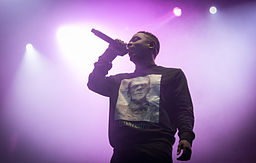
At first glance, it would seem unlikely that rap, a genre typically associated with racial and urban struggle, would find a significant following at a conservative college like Hillsdale. Nevertheless, students and faculty alike have professed a liking for the genre.
“You find a lot of freshness in rap music that’s not present in other genres,” Assistant Professor of English Dutton Kearney said. “There’s something about the medium that just encourages innovation. That’s what draws me in, at least. I want to hear something I haven’t heard before.”
Kearney said he believes rap has become popular in places like the Hillsdale community because the genre appeals to something deeper within the listener than just the crave for a catchy chorus.
“Rap is smart,” Kearney said. “You can only have so many pick-up-truck-drink-beer songs. Or even ‘Bad Blood’ or ‘Shake It Off.’ They’re fun for a couple of listens, and then they get tired,” he said. “Rap’s appeal is that it is doing something deeper than other forms of music. And we already read a lot of deep things here.”
In addition, Kearney believes rap allows musicians to build on the work of past masters in way other genres do not permit.
“For example, making nods to James Brown or George Clinton, and then incorporating their music into an album in 2016 is a way of having a conversation with the past that incorporates the contributions of the past, but then moves the genre forward,” Kearney said. “You don’t really see that happening in many other genres.”
Kearney clarified, however, that not all rap channels a significant amount of depth.
“I’m not really a fan of rap that says, ‘I’ve got a bigger car,’ or ‘I’ve got more gold,’” he said.
Senior Forester McClatchey, an aspiring rapper, explained how he first was attracted to the genre.
“In the beginning, I mostly rapped because of perceived communal value,” he said. “It’s probably the easiest way to make music: no instruments, no singing talent necessary. I suspect it also accesses what is fundamental in music: rhythm, narrative, experimenting with how words feel on your tongue.”
McClatchey said he began rapping freestyle with his friends, and the hobby became creative.
“It was not a decision, more like an organic outgrowth of juvenile trash-talking and a desire to participate in a creative community,” he said. “It was my way of joining the band from an alternate angle of approach.”
McClatchey agreed with Kearney’s assertion that reading deep things disposes a person to better appreciate the lyricism in serious rap albums. He noted Kendrick Lamar’s 2012 album “Good Kid, M.A.A.D. City” as an example.
“By studying old Augustan poets, for example, we’re pre-adapting our minds to appreciate what Kendrick is up to on ‘Good Kid,’” he said. “There are certain conventions (metrical, alliterative, rhyming, etc.) for crafting a sixteen-bar verse which Kendrick understands and consciously manipulates. Serious rappers work quite self-consciously in their tradition, and Hillsdale students can appreciate that.”
He also speculated deceased poets would appreciate the lyricism present in many of today’s rap albums.
“If Gerard Manley Hopkins were around today, I suspect he’d be impressed by the prosody of certain rappers,” he said. “Hopkins’ aggressive sense of meter has certainly influenced the way I rap. If Hopkins possessed any innate sense of rhythm, he could have spit mad, mad bars.”
Senior Chris McCaffery observed the poetic nature inherent to serious rap albums gives the genre a greater cultural meaning.
“When you look at popular music, rap is clearly more culturally significant because there’s a sort of realism to it, there’s a sort of natural humanity in the sort of composition that rap represents, as opposed to a Rihanna song or a Taylor Swift single,” he said.
He also noted that rap is so popular because it is simultaneously catchy and thoughtful.
“Popular rap can be well produced and corporately labelled, but it still has this note of someone composing something. You’re never going to get the depth of thought you’d find in a Kanye West album in a Taylor Swift album. There’s an equality of popularity, but in the case of rap music that doesn’t keep it from being thoughtful.”
McCaffery also noted that rap is more directly tied to actual human experiences and communities than other genres.
“Rap was always the product of a community before it was a commercial music form, insofar as it is something that has its roots in something that was done poetically by a group of people and not to simply produce a musical commodity,” he said.
Because of its roots in a community’s experience, McCaffery said that rap is an art form that can speak to a particular people’s experience in a universal way while still offering a broader comment on the human condition.
“One of art’s functions is that sort of mass communication,” he said. “In the same way that you don’t have to be Southern to read William Faulkner, or Christian to read Dante, and you don’t have to be an illiterate Greek man to read Homer, at the height of its artistic outlook, rap transcends the things that it is about and conveys something true about the human experience.”
